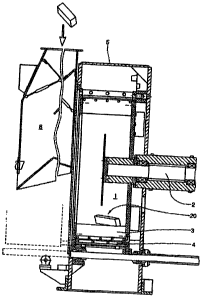Some of the information on this Web page has been provided by external sources. The Government of Canada is not responsible for the accuracy, reliability or currency of the information supplied by external sources. Users wishing to rely upon this information should consult directly with the source of the information. Content provided by external sources is not subject to official languages, privacy and accessibility requirements.
Any discrepancies in the text and image of the Claims and Abstract are due to differing posting times. Text of the Claims and Abstract are posted:
| (12) Patent: | (11) CA 2429152 |
|---|---|
| (54) English Title: | INTERMEDIATE PRODUCT, METHOD AND DEVICE FOR PRODUCING WOOD CHIPS |
| (54) French Title: | EBAUCHE, ET PROCEDE ET DISPOSITIF DE FABRICATION DE COPEAUX A PARTIR DE BOIS |
| Status: | Deemed expired |
| (51) International Patent Classification (IPC): |
|
|---|---|
| (72) Inventors : |
|
| (73) Owners : |
|
| (71) Applicants : |
|
| (74) Agent: | |
| (74) Associate agent: | |
| (45) Issued: | 2008-08-05 |
| (86) PCT Filing Date: | 2001-10-27 |
| (87) Open to Public Inspection: | 2002-05-30 |
| Examination requested: | 2003-08-28 |
| Availability of licence: | N/A |
| (25) Language of filing: | English |
| Patent Cooperation Treaty (PCT): | Yes |
|---|---|
| (86) PCT Filing Number: | PCT/EP2001/012460 |
| (87) International Publication Number: | WO2002/042039 |
| (85) National Entry: | 2003-08-28 |
| (30) Application Priority Data: | ||||||
|---|---|---|---|---|---|---|
|
The invention relates to an intermediate prod-
uct, a method for processing an intermediate product and a
wood-chipping device for processing an intermediate product.
The intermediate product (20) is substantially rod-shaped and
is between one and two times as long as oriented strand (OS)
chips. The intermediate product is fed to a wood-chipping de-
vice comprising a large number of blades (4), whose cutting
edges run at least approximately parallel to the blade ring axis
(2) and which enclose a working chamber. The intermediate
product is rotated about the blade ring axis and is aligned in
such a way that it lies substantially parallel to said ring axis
and is pressed by centrifugal force against the cutting edges of
the blades.
Image
L'invention concerne une ébauche, un procédé de traitement d'une ébauche, et un outil d'enlèvement de copeaux destiné au traitement d'une ébauche. L'ébauche (20) se présente essentiellement sous la forme d'une tige, et présente une longueur allant du simple au double de la longueur de copeaux orientés. L'ébauche est alimentée dans un outil d'enlèvement de copeaux comportant une pluralité de lames (4) dont les tranches s'étendent de manière au moins approximativement parallèle à l'axe de rotation (2) et renferment un espace de travail. L'ébauche est mise en rotation autour de l'axe de rotation, ladite ébauche étant orientée de manière à s'étendre essentiellement parallèlement à l'axe de rotation, et à être comprimée contre les tranches des lames sous l'effet de la force centrifuge.
Note: Claims are shown in the official language in which they were submitted.
Note: Descriptions are shown in the official language in which they were submitted.

For a clearer understanding of the status of the application/patent presented on this page, the site Disclaimer , as well as the definitions for Patent , Administrative Status , Maintenance Fee and Payment History should be consulted.
| Title | Date |
|---|---|
| Forecasted Issue Date | 2008-08-05 |
| (86) PCT Filing Date | 2001-10-27 |
| (87) PCT Publication Date | 2002-05-30 |
| (85) National Entry | 2003-08-28 |
| Examination Requested | 2003-08-28 |
| (45) Issued | 2008-08-05 |
| Deemed Expired | 2019-10-28 |
There is no abandonment history.
| Fee Type | Anniversary Year | Due Date | Amount Paid | Paid Date |
|---|---|---|---|---|
| Application Fee | $300.00 | 2003-05-14 | ||
| Maintenance Fee - Application - New Act | 2 | 2003-10-27 | $100.00 | 2003-05-14 |
| Request for Examination | $400.00 | 2003-08-28 | ||
| Reinstatement of rights | $200.00 | 2003-08-28 | ||
| Registration of a document - section 124 | $100.00 | 2004-03-05 | ||
| Maintenance Fee - Application - New Act | 3 | 2004-10-27 | $100.00 | 2004-08-24 |
| Maintenance Fee - Application - New Act | 4 | 2005-10-27 | $100.00 | 2005-10-27 |
| Maintenance Fee - Application - New Act | 5 | 2006-10-27 | $200.00 | 2006-09-27 |
| Maintenance Fee - Application - New Act | 6 | 2007-10-29 | $200.00 | 2007-10-25 |
| Final Fee | $300.00 | 2008-05-05 | ||
| Maintenance Fee - Patent - New Act | 7 | 2008-10-27 | $200.00 | 2008-09-25 |
| Maintenance Fee - Patent - New Act | 8 | 2009-10-27 | $200.00 | 2009-10-22 |
| Maintenance Fee - Patent - New Act | 9 | 2010-10-27 | $200.00 | 2010-09-27 |
| Maintenance Fee - Patent - New Act | 10 | 2011-10-27 | $250.00 | 2011-09-15 |
| Maintenance Fee - Patent - New Act | 11 | 2012-10-29 | $250.00 | 2012-10-13 |
| Maintenance Fee - Patent - New Act | 12 | 2013-10-28 | $250.00 | 2013-10-08 |
| Maintenance Fee - Patent - New Act | 13 | 2014-10-27 | $250.00 | 2014-09-22 |
| Maintenance Fee - Patent - New Act | 14 | 2015-10-27 | $250.00 | 2015-10-13 |
| Maintenance Fee - Patent - New Act | 15 | 2016-10-27 | $450.00 | 2016-10-14 |
| Maintenance Fee - Patent - New Act | 16 | 2017-10-27 | $450.00 | 2017-09-29 |
Note: Records showing the ownership history in alphabetical order.
| Current Owners on Record |
|---|
| B. MAIER ZERKLEINERUNGSTECHNIK GMBH |
| Past Owners on Record |
|---|
| LOTH, ROBERT |